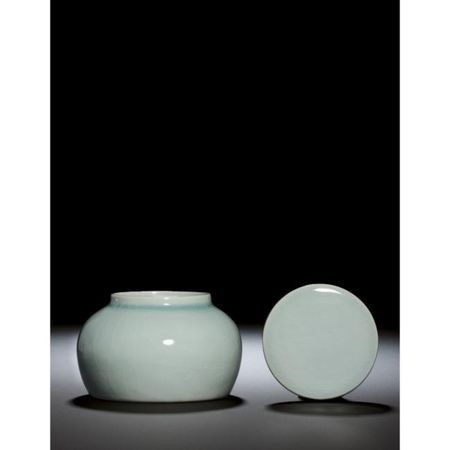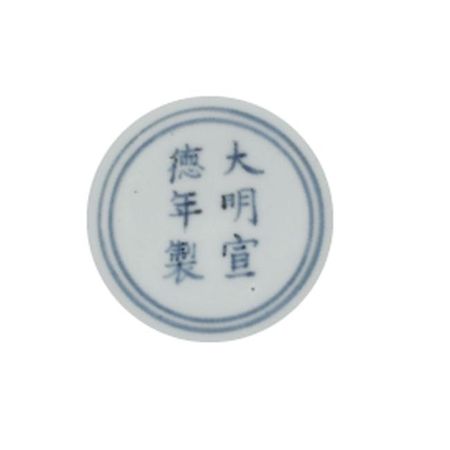A 'wintergreen' glazed & two white-glazed bowl. Ming dynasty, Yongle & Xuande mark and period
An exceptionally rare 'wintergreen' glazed chess jar and cover. Ming dynasty, Yongle period. photo courtesy Sotheby's
singularly beautiful, finely-potted in a compressed globular form, the elegant body on a broad flat base with tapered sides extending to softly rounded shoulders and rising to a short neck, veiled in an exquisitely rich and silky 'wintergreen' glaze thinning at the mouthrim and pooling around the shoulders in a sea-green tone, suffused with random silver threads of cracklure, the low flat cover similarly glazed. 12 cm., 4 3/4 in. Est. 7,000,000—9,000,000 HKD Sold 9,844,000 HKD
NOTE
A Unique Wintergreen Jar and Cover
The Yongle period was one of the most active periods for China's craftsmen and can be considered the most important period for China's porcelain production. No other reign – except perhaps the Yongzheng period of the Qing dynasty (1723-35) three-hundred years later – was marked by such innovation in porcelain technology, imagination in design and rigorous pursuit of quality as that of the Yongle Emperor, whose rule commenced in Nanjing in 1403 and ended in Beijing in 1424. His The move of the capital to a new location required not only gigantic building work, but also necessitated the production of objects of all kinds by specially designated imperial workshops to fill the newly constructed palace halls. Imperial workshops created porcelain, lacquerware, cloisonné, textiles and Buddhist gilt bronzes of unparalleled excellence and Chinese crafts as a whole experienced an unprecedented flowering.
The imperial porcelain workshops at Jingdezhen in Jiangxi province increased quantity as well as quality of their production with awesome rapidity, as the excavations of the waste heaps of the Ming imperial kilns have documented. As new pigments and firing techniques, new shapes and designs were tried out, the potters' technical leap forward was so immense, that thereafter no real innovation took place for centuries, until the introduction of foreign technology from the West in the 18th century supplied once more new impulses.
This exquisite little jar and cover embody some of the Yongle period's most remarkable achievements: its shape, which appears to be previously unrecorded, impresses through its simplicity, its glaze colour dazzles through its subtlety.
The wide range of different glaze colours and tones achieved at the Yongle imperial kilns was a triumph of the craftsmanship of the early Ming potters. Various pale green glazes, sometimes more yellowish-green in tone and then interpreted as imitating Longquan celadon, sometimes more greyish as if imitating guan ware, and sometimes bluish like the present example and then referred to as dongqing, 'wintergreen', or cuiqing, 'jadeite green', began to be achieved at Jingdezhen in the early Ming period. A light green glazed stem bowl with an engraved Yongle reign mark and of the period was sold in these rooms 24th November 1981, lot 133. Both a yellowish and a bluish green glaze colour are also known from some deep conical bowls with incised lotus scrolls, attributed to various 15th-century periods; for a bluish-green example see the bowl sold in these rooms 30th April 1996, lot 355, and exhibited at the Min Chiu Society exhibition Monochrome Ceramics of the Ming and Ch'ing Dynasties, Hong Kong Museum of Art, Hong Kong, 1977, cat. no. 56.
Small jars were in the Yongle reign created in a range of shapes, often with small lugs, and rarely with this type of cylindrical disc-shaped cover; see a line drawing in Geng Baochang, Ming Qing ciqi jianding [Appraisal of Ming and Qing porcelain], Hong Kong, 1993, p. 27, fig. 44. Their function is not completely clear. The present form is reminiscent and may have been inspired by drum-shaped chess piece jars which in the Song (960-1279) and Yuan (1279-1368) period were created by many Chinese kilns, although their shape is much simpler in concept (compare a Yuan blue-and-white example from Jingdezhen included in exhibition Jingdezhen chutu Yuan Ming guanyao ciqi [Yuan and Ming imperial porcelain excavated at Jingdezhen], Yan-Huang Art Museum, Beijing, 1999, cat.no.1).
The most closely related Yongle shape is that of a small jar and cover of very similar form, but with three small lugs attached around the shoulder. One example from the Qing court collection, also with a pale green glaze, is still in Beijing, see The Complete Collection of Treasures of the Palace Museum: Monochrome Porcelain, Hong Kong, 1999, pl.123, also illustrated in Zhongguo taoci quanji [Complete series on Chinese ceramics], vol.13, Shanghai, 2000, pl.10; a second green-glazed example exists in the National Palace Museum, Taiwan, published in Minji meihin zuroku [Illustrated catalogue of important Ming porcelains], vol. 1, Tokyo, 1977, pl. 32.
A monochrome white jar and cover of that shape, with three lugs and with incised decoration, was in the Kempe collection, see Bo Gyllensvärd, Chinese Ceramics in the Carl Kempe Collection, Stockholm, 1964, pl.664. This basic shape, but with a smaller cylindrical cover, was also used for ewers, with spout , handle and again three lugs attached; for a monochrome white example see Minji meihin zuroku, op.cit., pl. 31.
A monochrome 'sweet-white' jar without lugs – like the present example – but lacking a cover and with incised decoration is in the Shanghai Museum, see Lu Minghua, Shanghai Bowuguan cangpin yanjiu daxi: Mingdai guanyao ciqi, Shanghai, 2007, pl. 4-12. Another with a stepped, domed, knopped cover (which may or may not belong) is in the National Palace Museum, Taiwan, published in Teresa Tsao, Mingdai chunian ciqi tezhan mulu/Catalogue of a Special Exhibition of Early Ming Period Porcelain, Taipei, 1982, cat.no.55. Similar jars, without covers, are also known with blue-and-white decoration of garden flowers; see, for example, a piece sold in these rooms, 29th April 1997, lot 532.
This form, with small differences in the profile, became a popular jar shape in the Chenghua reign (1465-87); see three different jars, all lacking covers: a blue-and-white one of Chenghua mark and period in the Meiyintang collection, illustrated in Regina Krahl, Chinese Ceramics from the Meiyintang Collection, London, 1994, vol. 2, pl. 678; a polychrome painted jar, also of Chenghua mark and period, in a private collection, published in the exhibition catalogue The Emperor's Broken China, Sotheby's, London, 1995, p.109, fig.2; and an unmarked polychrome painted jar in the Palace Museum, Beijing, in Geng Baochang, ed., Gugong Bowuyuan cang gu taoci ciliao xuancui [Selection of ancient ceramic material from the Palace Museum], Beijing, 2005, vol.1, pl.124. A related shape, with a slight variation in profile, but with a similar disc-shaped cover was also used for Chenghua jars marked with the character tian, such as the example excavated at Jingdezhen and included in the exhibition Jingdezhen chutu Yuan Ming guanyao ciqi, op.cit., cat. no. 327.
A fine and rare incised white-glazed bowl. Ming dynasty, Yongle period. photo courtesy Sotheby's
the deep rounded sides rising elegantly from the thick straight foot before gently flaring at the rim, finely incised on the exterior with large detached sprays of lotus, camellia, rose and peony with their respective buds, the interior with a medallion of two pomegranates on a leafy branch, applied overall with an opaque milk-white glaze displaying a light bluish-grey tint along the incised design. 16.8 cm., 6 in. Est. 1,500,000—2,000,000 HKD - Sold 1,820,000 HKD
PROVENANCE: Sotheby's New York, 4th June 1982, lot 215.
Sotheby's London, 17th November 1999, lot 750.
NOTE: Two slightly larger bowls with similar incised designs from the Kempe collection in the Museum of Far Eastern Antiquities, Stockholm, are illustrated in The World's Great Collections. Oriental Ceramics, vol.8, Tokyo, 1982, nos. 206 and 210. Compare also a smaller undecorated white bowl from the early Yongle stratum of the Ming Imperial kiln site, included in the exhibition Imperial Porcelain of the Yongle and Xuande Periods Excavated from the Site of the Ming Imperial Factory at Jingdezhen, Hong Kong Museum of Art, 1989, cat.no.16.
A fine large 'lianzi' white-glazed bowl. Mark and period of Xuande. photo courtesy Sotheby's
finely-potted, the rounded sides rising from a short slightly tapered foot, the exterior faintly incised in the body with two rows of lotus petals radiating from the foot, below a band on incised waves encircling the mouth, the interior incised with a pair of pomegranates sprigs enclosed within a double-circle medallion on the base, the mouth encircled by a register of key-fret, all beneath a white glaze, the base with a six-character mark in underglaze-blue within double-circles. 20.5 cm., 8 1/8 in. Est. 800,000—1,000,000 HKD - Sold 1,160,000 HKD
NOTE: Compare a very similar bowl from the Kempe Collection, illustrated in Bo Gyllensvärd, Chinese Ceramics in the Carl Kempe Collection, Stockholm, 1964, pl. 676 and later sold in our Paris rooms, 12th June 2008, lot 44.
The Xuande lianzi bowl is based on the Yongle bowl of the same proportions. Compare a Yongle period bowl from the Kempe Collection with a single tier of lotus petals, illustrated in ibid. pl. 686, and later sold in our Paris rooms, 12th June 2008, lot 40. And another one from the Donald S. Morrison collection sold in our New York rooms, 4th June 1982, lot 214 and again in these rooms 17th May 1988, lot 36.
Sotheby's. Fine Chinese Ceramics & Works of Art. 08 Oct 09. Hong Kong www.sothebys.com

/https%3A%2F%2Fprofilepics.canalblog.com%2Fprofilepics%2F1%2F0%2F100183.jpg)









/http%3A%2F%2Fstorage.canalblog.com%2F81%2F58%2F119589%2F64812826_p.jpg)
/http%3A%2F%2Fstorage.canalblog.com%2F35%2F43%2F119589%2F64250078_p.jpg)
/http%3A%2F%2Fstorage.canalblog.com%2F23%2F44%2F119589%2F64238987_p.jpg)
/http%3A%2F%2Fstorage.canalblog.com%2F96%2F20%2F119589%2F63693368_p.jpg)